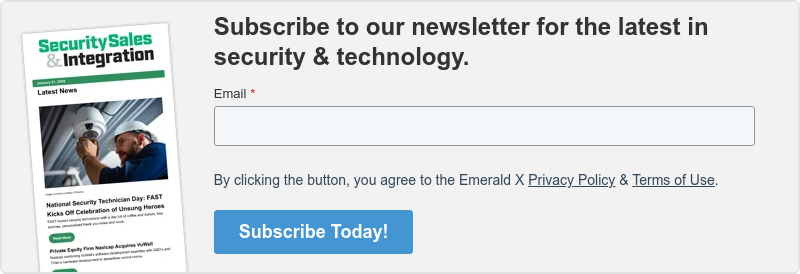Surveillance cameras are a staple of security in commercial buildings, stadiums, hotels, and schools. Yet, many organizations neglect to keep their cameras properly and routinely maintained, compromising their effectiveness when it matters most.
A fall 2024 audit of New York City Transit highlighted the severity of this issue. Among a sample of more than 1,000 cameras and other pieces of equipment, approximately 900 had been slated for preventative maintenance. However, the Metropolitan Transportation Authority (MTA) could only verify that 300 of them had been serviced.
This widespread lapse in camera upkeep is a preventable problem. With greater awareness and consistent maintenance practices, organizations can ensure their surveillance cameras remain reliable, providing the security they were designed to deliver.
Surveillance Camera Blind Spots and Obstructions
While surveillance cameras are the most common security measure, they often serve as little more than a tool for reviewing incidents after they occur, providing digital evidence rather than preventing threats in real-time. As a result, many institutions fail to realize that their cameras are not actually monitoring the areas they should be.

Thoughtful placement is essential when deploying or reviewing camera systems to ensure that the cameras are working as designed. Common areas, entrances, and parking lots should be prioritized. However, because cameras rely on electricity and require clear sightlines, installers sometimes prioritize convenience over effectiveness.
Instead of taking the time to drill through walls and run additional cables, cameras are often positioned in areas that are simply “good enough.”
True security demands more than just placing surveillance cameras where it’s easiest. Institutions must make sure that their surveillance systems provide comprehensive coverage, not just the illusion of it.
Directional placement is another critical factor. Due to the variety of camera types, including dome, bullet, PTZ (Pan, Tilt, Zoom), turret, fisheye, etc., it’s not always obvious where a camera lens is pointing. As a result, obstructions can go unnoticed.
These obstructions may be permanent, like a surveillance camera mistakenly aimed at a wall, or temporary, such as a misplaced sign. Seasonal changes can also create issues, especially outdoors. Tree limbs that are thin and unobstructive in winter can become significantly denser when covered in spring leaves or flowers, blocking crucial sightlines.
If a camera has already been placed, a little proactive maintenance like regular trimming can go a long way.
Regular Updates and Restarts
While surveillance camera placement is crucial, ensuring the camera itself is functioning properly is just as important. Many security professionals tasked with maintaining cameras around buildings aren’t necessarily camera technicians, so when issues arise, they may not know how to address them.
An often overlooked aspect of cameras is that they are essentially computers. Much like a laptop that begins to slow down, the simplest and most effective solution is often to restart it. Yet, cameras rarely receive this basic maintenance.
Over time, the failure to reboot surveillance cameras leads to problems that could be easily avoided with a simple reset.
Another key factor in maintaining camera performance is making sure to keep up with the latest firmware updates. Running firmware that’s several years old can lead to performance issues and vulnerabilities. In fact, in many cases, when a new video management system (VMS) appears incompatible with existing cameras, the problem is just outdated firmware.
The update process generally only takes 10 minutes for downloading and an hour for installation, but the performance improvements can be substantial. Updates should be scheduled during periods of low-security risk to minimize disruption.
As for the surveillance camera itself, it should be replaced every seven years. Like all technology, it naturally deteriorates over time due to factors such as environmental exposure and everyday wear and tear, which can lead to issues like blurry images and malfunctions.
However, with proper maintenance, surveillance cameras can operate at peak performance during their entire lifespan.
Surveillance Camera Weather-Proofing All Year Round
Weather conditions not only contribute to the physical deterioration of the camera body but can also impact its functionality. As temperatures fluctuate between extremes, it is essential to regularly inspect the camera and its footage to make sure it is operating correctly.
Different types of weather changes can also affect the surveillance camera’s field of vision. Just as seasonal vegetation growth can obstruct views, inclement weather conditions, such as snowstorms or ice storms, can create physical barriers to effective surveillance.
After such events, it’s important to check that the camera lenses are clear and unobstructed. Another factor to consider is the effect of sunlight on camera visibility. During certain times of day, sunlight can cause a glare, impairing the surveillance camera’s ability to capture clear footage. Installing a shade cover can easily mitigate this issue, as long as one is aware of when and where glare may occur.
Lastly, outdoor cameras are susceptible to dirt and debris. Cleaning them once a year can make a noticeable difference in performance. In fact, a simple annual dusting is far more effective than the infrequent maintenance most cameras receive.
The effectiveness of surveillance systems hinges on more than just their initial installation; it requires ongoing attention and proactive maintenance. Regular camera placement reviews, firmware updates, and simple actions like rebooting can significantly enhance a camera’s performance and reliability.
Additionally, accounting for environmental factors, such as weather conditions and natural obstructions, ensures that cameras continue to provide the comprehensive coverage for which they were intended. By embracing these practices, organizations can maximize the lifespan and functionality of their surveillance systems, ensuring they remain a true asset in safeguarding premises and people.
Rob Huberty is the chief operating officer and co-founder of ZeroEyes.
https://www.securitysales.com/insights/why-surveillance-camera-maintenance-matters/612422/

